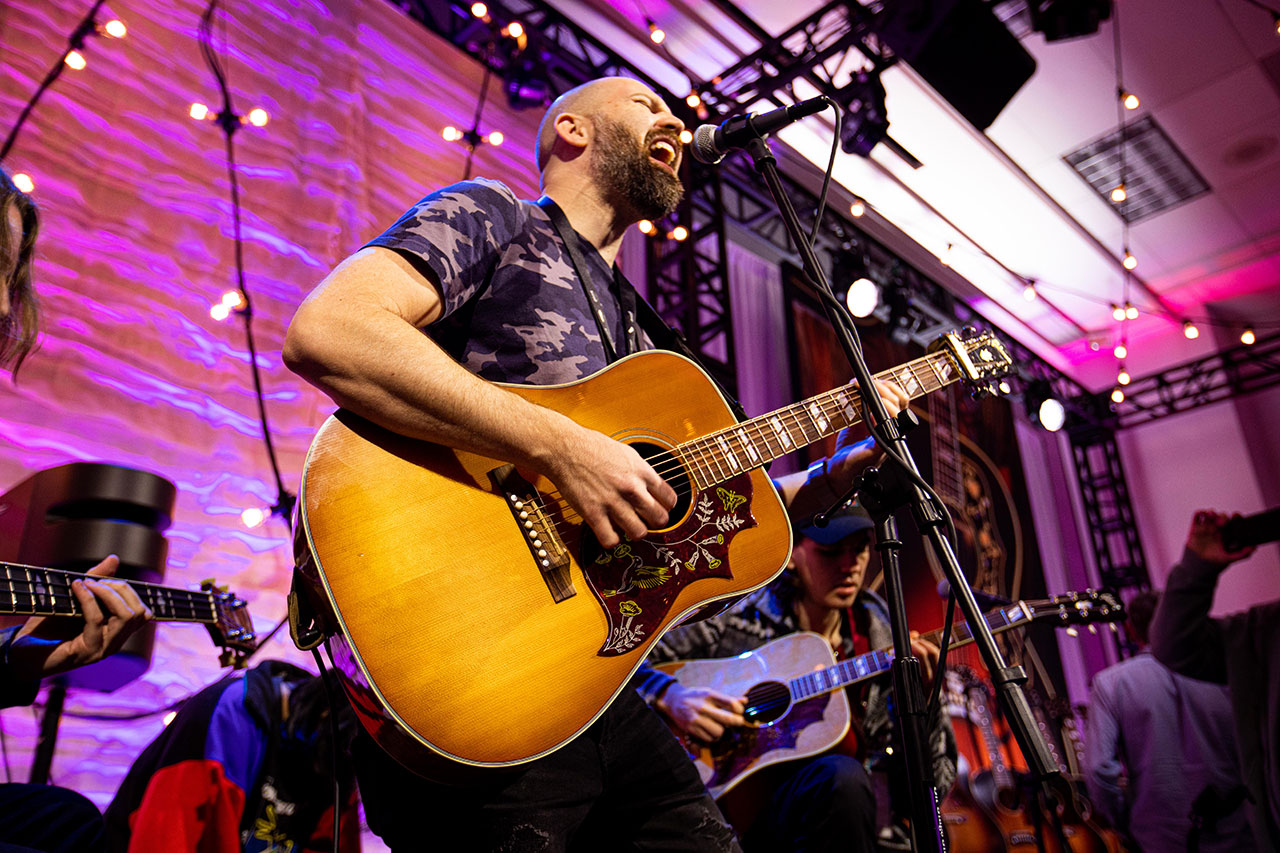Read this essential advice before gigging with acoustic guitars to ensure a smooth experience and killer performance
While electric guitars are designed to cut through a mix and handle a variety of effects, their acoustic counterparts require a more nuanced approach to balance their natural warmth with practical sound reinforcement—especially when gigging. Acoustic guitars must also be handled with care every step of the way, from the ride to the gig until you get home. Careful thought, preparation, and the right gear will ensure a great performance and the best sound possible, so let’s look at some best practices when gigging with acoustic guitars.
Be prepared!
The key to any successful performance is also the first thing you have to do: prepare yourself for anything that can (and will) go wrong before you get to the gig. Sounds simple, right? That’s because it is. The importance of this step can’t be overstated, so pay attention!
Do: Protect your guitars
Acoustic guitars have many inherent traits that make them delicate instruments, so the first thing to consider is safety and security, both to and from the gig as well as while you’re on stage. While a sturdy soft case might be fine for some shows and the best option when using public transport, a hardshell case provides better protection and peace of mind, especially if your instrument is going to be traveling in the back of a van, or likely to be stored in backstage areas while other bands are setting up.
Both Gibson and Epiphone have you covered with a range of cases and gig bags for your treasured instruments, so don’t neglect this important part of a successful gig.
On stage, heavy-duty stands are recommended, and there are plenty of options out there specifically for acoustics with enhanced stability to avoid an accidental fall. Position your guitars and stands where they are accessible but also out of harm’s way from other band members or crew who need to access the stage.
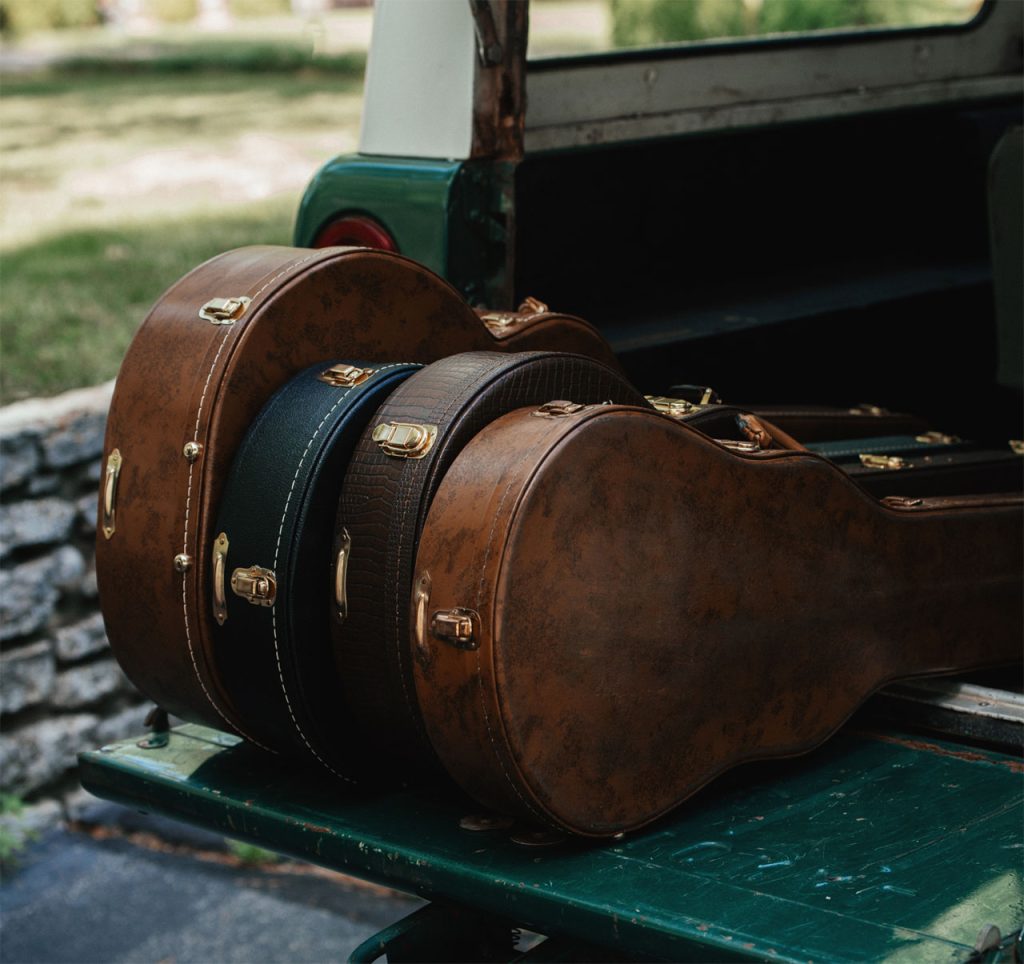
Image: Gibson offers a variety of case choices
Don’t: Rely on a single instrument
One of the best ways to be prepared for anything that could go wrong with your acoustic is to have backups. Break a string? Tuning issues? Fussy electronics? No problem. With extra instruments at the ready, these obstacles are easily overcome to keep the show on track.
If you’re on a budget, choose an instrument that favors function and playability over premium aesthetic touches. A no-frills, perfectly playable instrument can be had for much less than you may think.
Epiphone offers a wide range of acoustic guitars for nearly every style and budget. Part of the Modern Acoustic series, the Inspired by Gibson™ J-45™ EC comes equipped with reliable Fishman® electronics and enhanced upper fret access. The Epiphone Made in USA Collection offers gorgeous, stage-ready, reproductions of rare and classic instruments with plenty of vintage vibes, and the Inspired by Gibson Custom Collection features models built in collaboration with the luthiers of the famous Gibson Custom Shop.
Stepping up to Gibson acoustics, you’ll find the finest handcrafted instruments, each endowed with one of music’s richest pedigrees. The Modern Acoustic Collection enhances the playability of classic models like the Hummingbird™ and J-45 Standard, making them ideal for today’s performing musicians.
The importance of having a backup can’t be overstated. If you gig regularly with your acoustic, make it a priority to find a second or third guitar that will get you through the show should disaster strike—especially if you’re using open tunings with radical string-tension shifts. If you don’t have a backup guitar then you’d better know a good story to keep the crowd amused while you are restringing.
Do: Get your gear in order
One of the worst feelings is realizing you’ve forgotten something that’s essential to a successful performance. That sense of dread that creeps in as you frantically look for that capo, strap, or other must-have is easily avoidable. All it takes is developing a system that works for you, but here are some suggestions to get you started.
Keep gear and accessories grouped together appropriately so it’s easy to check quickly before leaving the house or rehearsal space for all necessary equipment. Backpacks with multiple sections are extremely handy for this, and most of us have one or two collecting dust in a closet that can serve this purpose. Each player should find what works best for their needs, but for example, you can keep essential cables together in one section, pedals and power supplies in another, and playing accessories like picks, capos, clip tuners, and straps in a third.
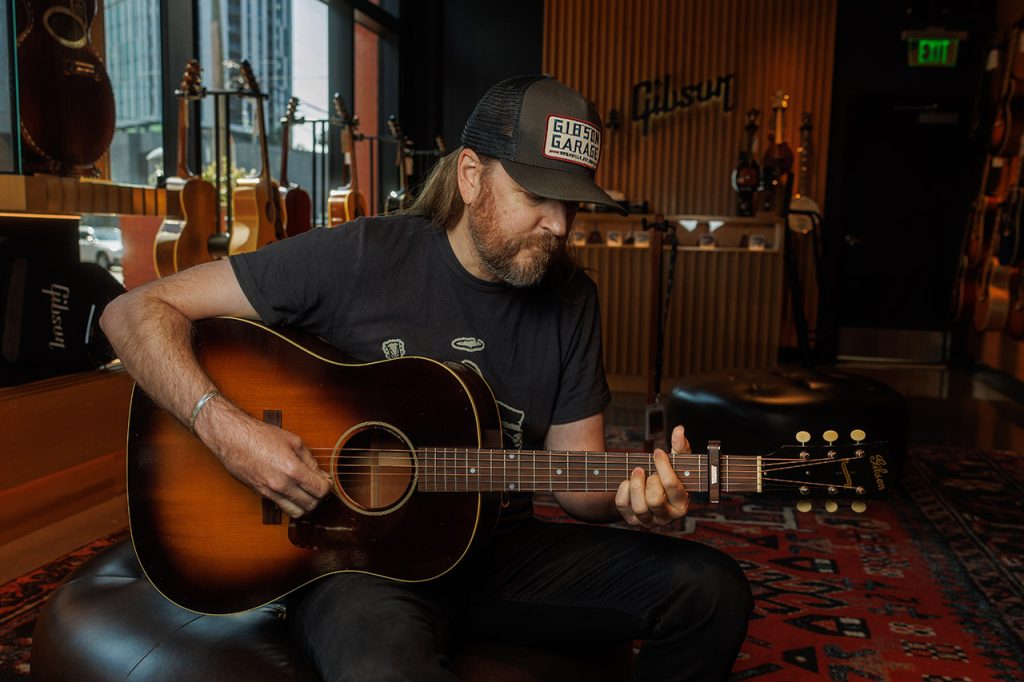
Image: The Gibson Garage stocks many of the items you need for gigging, including capos
Don’t: Forget the “extras”
If you’ve never arrived at a gig to find one shared power outlet (guaranteed to be at the wrong end of the stage), consider yourself lucky! When you inevitably face this reality, you’ll be happy to have a few things at your fingertips, like extension cords of varying lengths (preferably with a multi-outlet end), a power strip or two, and any adapters you may need to power effects pedals.
An outlet tester is an easy and affordable way to protect your gear from dirty power circuits and outlets. They’re readily available at any hardware or big-box home improvement store for a few bucks and well worth the investment. Bring extra batteries (typically of the 9-volt variety) to power any effects, tuners, and your instrument’s electronics. A battery tester is also a great item to have on hand to avoid having equipment die mid-show.
Setup and soundcheck
Now that we’ve covered preparation, let’s focus on what happens when it’s time to show up and play! The anticipation and excitement of performing make it easy to miss critical steps during setup, so as the saying goes, keep calm and carry on! Knowing everything is in its right place will allow you to keep your mind on your playing and performance.
Do: Arrive early
No matter how many gigs you’ve done, getting to the venue well ahead of time is always a good idea. Surveying the stage before it’s covered in gear and cables gives you a head start when it’s your turn to set up. Identify where the power sources are, how much room you’ll have on your side of the stage, and how to position your instruments, pedals, and amp (if you’re not running direct to the PA).
When it’s time to set up, all that preparation you did beforehand should make it easy to place your instruments and stands, route cables, and power your DI box and effects, leaving more time to make sure your sound is dialed in.

Image: Acoustic tri-bursts—the Gibson SJ-200, Hummingbird, and J-45
Do: Amplify correctly
Electro-acoustic guitars (sometimes known as acoustic-electrics) have a preamp and electronics that allow you to plug into an amplifier or DI box, just as you would with an electric guitar. There are many advantages of onboard electronics over a miked acoustic guitar, from simplifying setup and instrument changes to convenient tone-shaping options and feedback control.
A plugged-in electro-acoustic also gives you the freedom to move around the stage without being stuck in one position right in front of a microphone, so for active performers, it’s typically the best option. While an acoustic guitar through a nice microphone can sound great and might suit a smaller, more intimate gig where you’ll be seated most of the time, it’s almost always preferable to use an electro-acoustic guitar for a live performance.
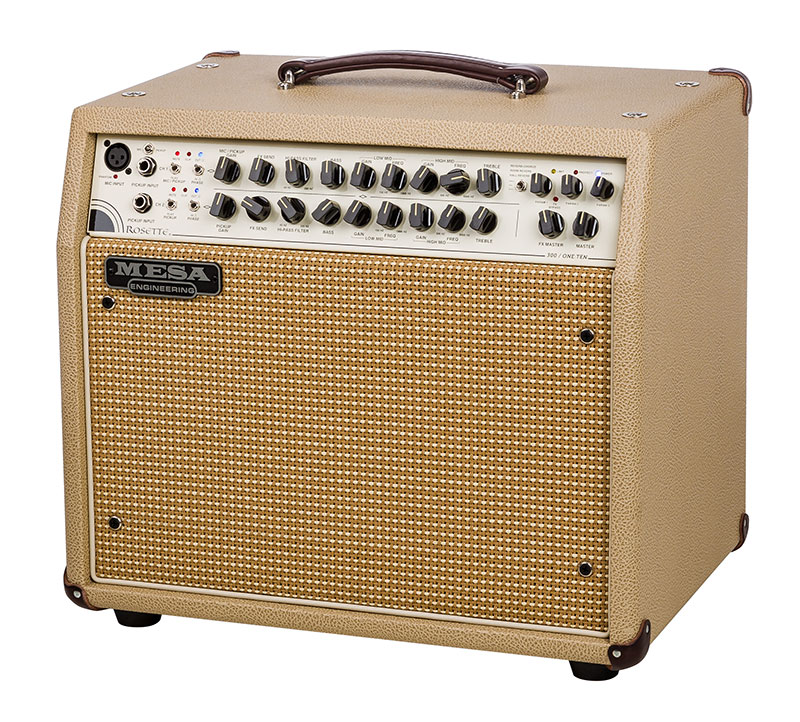
Image: Capture your acoustic’s tone with detail and clarity with the Rosette® 300 Acoustic Combo
Do: Get a DI box
When using your acoustic for live performance, a DI (or direct injection) box is highly recommended. Sound engineers typically have basic DI boxes on hand to convert unbalanced, high-impedance signals from keyboards and other instruments into soundboard-friendly, balanced signals that can handle long cable runs.
However, having your own ensures you’ll always provide the board with the best signal from your acoustic while eliminating hum and extraneous noise, ensuring the best signal integrity, and preserving the sound of your guitar. Some pedal-style acoustic guitar preamps have built-in DI outputs, so check your preamp first–you may already have what you need.
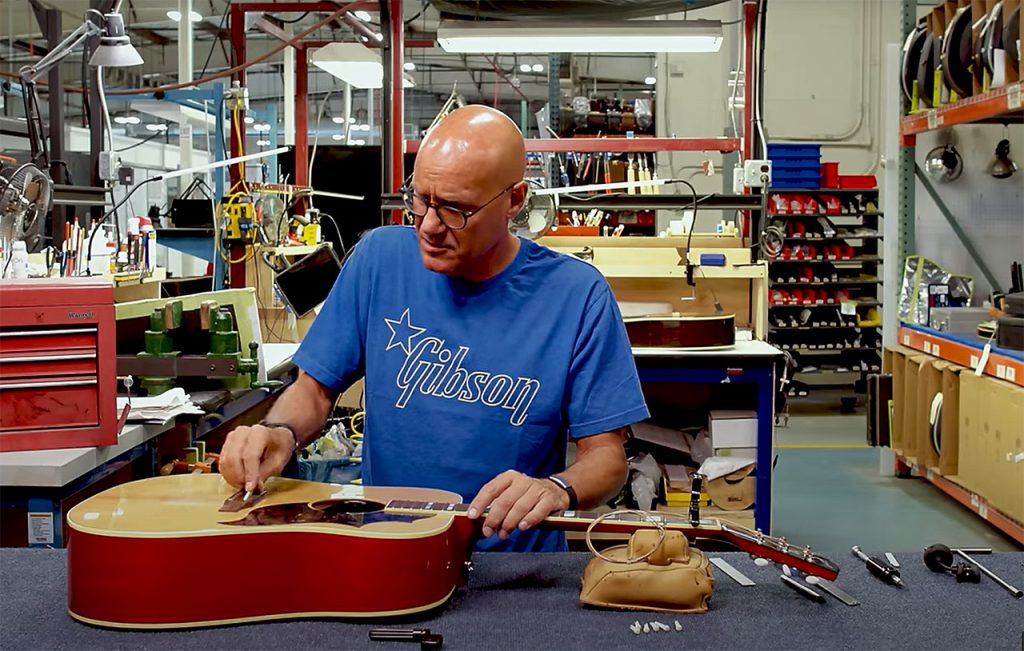
Image: If you need to install a strap button for your gig, Gibson Master Luthier Jim DeCola has you covered
Do: Get a proper soundcheck
Since acoustic guitars are much more prone to feedback, work with the sound engineer to achieve the volume and tone you’re after while leaving plenty of headroom in case your volume needs adjustment during the show. Also, leave some space in your EQ settings so you can roll off mids and highs in the event feedback occurs, as those higher frequencies are often the culprit. Other ways to control feedback include soundhole covers, changing your position onstage, or using a notch filter if your guitar is equipped with one.
Doing a proper setup and soundcheck without being rushed is essential to setting the mood for the entire gig. It’s nice to have a break between setting up and playing so you can grab a beverage, have a laugh with your bandmates, and transition smoothly from the technical side of setting up to the creative vibe of performing.
Don’t: Use too many effects
Unlike electric guitars and the countless effects that can dramatically change and shape the way they sound, acoustic guitars are better suited for lighter touches of modulation like chorus and time-based effects like delay and reverb to enhance their natural sound. Since these types of effects can be added at the PA’s mixing board, keep your signal chain simple to avoid any technical glitches and trust the hands at the board to make your acoustic guitar shine in the mix.
Break a leg!
The house music fades out, the lights go down, and the crowd goes wild—it’s time to play! When you’ve done your homework, prepared properly and rehearsed appropriately, and insured yourself against things that can go wrong, you’ll be able to play with confidence, knowing your acoustic is going to play like a dream and shine through in the mix.
Of course, there’s no guarantee that something won’t go wrong, but if you’ve taken the proper steps before the music starts, you’ll be ready to work through any issues quickly and efficiently to keep the show going.
Get many of the tools you’ll need to keep your guitars in tip-top shape here, and explore other articles where Jim DeCola explains the best guitar maintenance practices that will aid in successful gigging.

